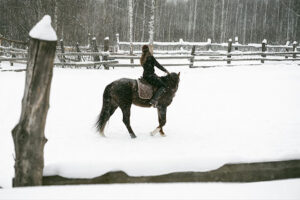How to Ride a Shoulder In
The shoulder in is one of the first lateral movements that appears in dressage tests. And if you want to progress up the levels, you’ll need to get very familiar with it – because you’ll be riding it even at the lofty heights of Inter 1! But aside from that, it’s also a really useful exercise […]

The shoulder in is one of the first lateral movements that appears in dressage tests. And if you want to progress up the levels, you’ll need to get very familiar with it – because you’ll be riding it even at the lofty heights of Inter 1!
But aside from that, it’s also a really useful exercise to incorporate into your schooling. So, let’s take a closer look at the shoulder in, what it can do for you, and how to ride it.
What Is the Shoulder In?
As the name indicates, the shoulder in is a movement where the horse moves the entire shoulder slightly to the inside, while still travelling straight.
The USDF definition of the shoulder in says “this exercise is performed in collected trot. The horse is ridden with a slight but uniform bend around the inside leg of the rider maintaining cadence at a constant angle of approximately 30 degrees. The horse’s inside foreleg passes and crosses in front of the outside foreleg; the inside hind leg steps forward under the horse’s body weight following the same track of the outside foreleg, with the lowering of the inside hip. The horse is bent away from the direction in which it is moving.”
Shoulder in is ridden on three tracks. So if you viewed the horse from, say, M and he was performing shoulder in left starting from F you would see the following:
- The outside hind leg making one track closest to the wall
- The inside hind leg and outside foreleg moving on the same track
- The inside foreleg making the third track, the furthest away from the wall.
Additionally, the horse would also show about a 30 degree angle with left flexion.
If you’re struggling to picture the idea of three tracks, here is a helpful diagram showing what the horse looks like when viewed from above.
Why Is It Useful?
There’s a reason the shoulder in is in so many dressage tests. And it’s not just because it looks pretty! In fact, shoulder in is often considered the foundation of dressage. It’s the first movement in which the horse learns to collect while moving laterally, and is incredibly useful for both suppling and straightening and getting the horse to “take” the outside rein from the inside leg.
Because the shoulder in teaches the horse to take more weight behind, to lift the shoulder, and to bend and thrust the inside hind leg, it also helps to development engagement and expression. Plus, it helps riders to learn to control the shoulder with precision which makes it easier to perform lateral movements as well as to turn neatly and easily.
Honestly, if it sounds like the shoulder in does everything, that’s because it does! If there’s one movement that will really improve your horse’s strength, balance, and way of going – this is it. So it’s worth getting it right and spending some time really developing a good shoulder in.
Hopefully, you’re now convinced that the shoulder in should become part of your training repertoire! So how exactly do you ride it?
How to Ride The Shoulder In
When you’re first learning to ride the shoulder in, or are teaching a green horse the movement, it’s often easiest to start by riding a 10m circle before going into the shoulder in. This is because it sets the horse up with the correct bend through the body.
So if you were going to ride a shoulder in left, here’s a step by step process:
- Ride a 10m circle left at collected sitting trot at F.
- As you return to F having completed the 10m circle, pretend that you’re about to start a second circle.
- When the very first step of the second circle begins and the horse’s shoulders come away from the wall, you will ask the horse to keep his shoulders there while travelling down the long side with the rest of his body.
- To do this, half halt on your outside rein and use your inside leg at the girth as well as your inside seatbone down the long side.
- Keep the outside leg behind the girth to prevent the quarters from swinging out.
- The inside rein creates left flexion while the outside rein controls the angle of the shoulders, the bend of the neck, and prevents the horse from running or falling through the outside shoulder.
- The inside leg used at the girth can then add impulsion by asking the horse’s inside leg to flex and cross underneath his body.
While you are riding this movement, be sure not to twist your upper body. Think of keeping your shoulders parallel to your horse’s shoulders. Initially, ride only a few strides before straightening the horse and rewarding him.
Here is a video showing a good shoulder in for a horse at around second level.
Mistakes To Be Aware Of
When you read the steps above and watch the video of the horse moving gracefully into and out of shoulder in, it looks easy. But when it comes to collection and lateral work, there’s always some technicalities hiding away.
There are a couple of common errors that riders make when riding shoulder in. Here’s what to keep in mind:
- Pushing the quarters out instead of moving the shoulder inwards is one of the biggest mistakes riders make during the shoulder in. Make sure you’re actually bringing the shoulder around your inside leg and displacing the forehand, not simply allowing your horse to swing out the quarters.
- Asking for too much angle. If you have the shoulders too far off the track, it becomes a four track movement and the suppling and strengthening benefits are lost. When this happens, it’s more of a leg yield along the wall than a shoulder in. Instead, make sure the horse is bent through the rib cage. It’s better to ride an angle that’s too small than too big when you’re learning.
- Using too much neck bend is another common fault. Riders often overuse the inside rein and cause the neck to bend too far to the inside, instead of bending the horse’s body around the leg.
- Losing impulsion and engagement is another common fault. This can happen for a number of reasons and is common when training a horse. Often, they simply don’t have the strength or balance to maintain the shoulder in for long periods. If your horse gets “stuck” or loses impulsion, straighten up and ride forward to ensure he is in front of the leg before asking again. Remember not to ask more than your horse is physically capable of in any given session either.
When you’re riding shoulder in, it’s best to have a trainer or experienced friend on the ground to watch you. That way, they can tell if you’re making any of the above mistakes even if you can’t feel it. If you happen to have arena mirrors or can video yourself riding it, that can be very helpful too!
Conclusion
Will you be adding shoulder in to your schooling routine? Or do you already work on it regularly? Let us know in the comments.







